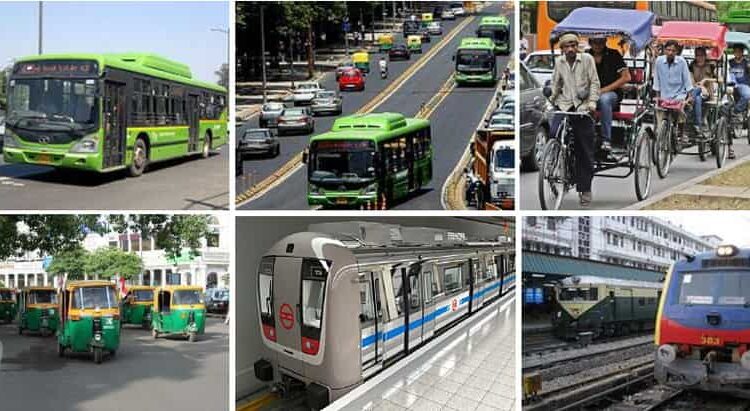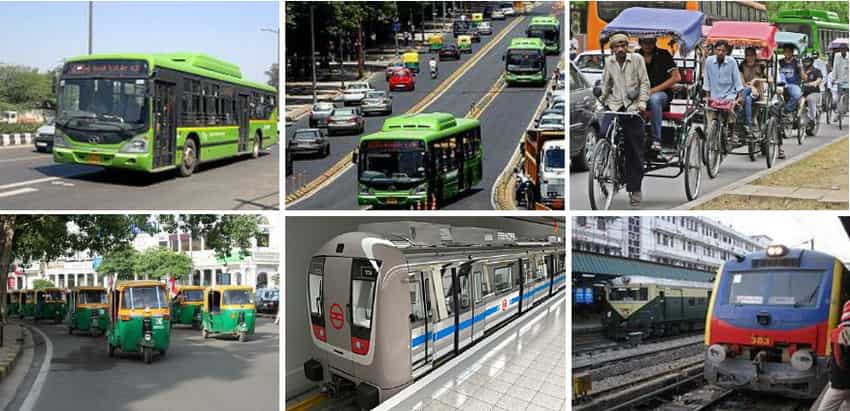Delhi, the National capital and a Union territory of India is the second largest in terms of population in the country. There are a lot of things to do and places to visit in Delhi in every sector like historical places, monuments, shopping malls, food section and religious sites. The historical places include Qutub Minar, Humayun’s Tomb, Gurudwara Bangla Sahib, India Gate, Gandhi Smriti, Red Fort, Rajghat, Agrasen ki Baoli and much more. The Ahimsa Sthal, Lotus Temple, Jama Masjid, Hazrat Nizamuddin Dargah, Akshar Dham, Birla Mandir Temple and Jagganath Temple are the famous places to worship. The famous malls include Pacific Mall, The Great India Place, DLF Promenade, Ten-second take away, Select Citywalk etc. One can traverse around the city by the following means :
- Delhi Metro
- Buses
- Auto Rickshaw
- Cab/Taxi
The transport management system falls in the able hands of the Transport Department of Delhi. However, the busy city is not an easy bug to master in terms of travel and conveyance. So, here’s a detailed Local Transport Guide as to How to Travel in Delhi.
The main transport lifelines of the city are the Metro, DTC buses, Autorickshaws, E-rickshaws and Cabs. Out of these, the most viable are the buses and the metro train because they cover maximum distance in economical fares.
The first one is the Delhi Metro, the technologically savvy and omnipresent in all parts of Delhi.
1- Delhi Metro
The Delhi Metro is run by Delhi Metro Rail Corporation. It has brought a modern twist to means of transportation in a heavily crowded city like Delhi, which was a first in India. The metro runs along an elephantine distance of 350.42 Km with 256 stations at present. All districts, North, South, East, and West of Delhi are well-connected through 10 lines. Moreover, these lines also extend up to Gurgaon and Faridabad in Haryana, Noida, and Ghaziabad in Uttar Pradesh. The Metro links all major Railway stations as well as the local and international airport, making travel easier. So, there’s nothing wrong with admitting that the Metro project in Delhi has made a life for Delhiites, a lot easier and time-effective.
Traveling in Delhi is easier, you just need to find out the nearest Metro station to the place you are at and the place you want to reach. A mobile application is available to help you to do that. The tickets are available at the stations as tokens as well as cards. If you choose to buy a smart-card, as it is called, then you save yourself from long queues. But if your travel in the Metro seldom, then a token will do too. The fares are economical and do not cost more than 40-50 rupees. Moreover, it is generally on time and you shall reach your destination in record time, that too hassle-free and in an air conditioned Metro train.
Helpline– 155370
2- DTC Buses
For the past few decades, major transportation in Delhi has depended entirely on the DTC Buses. Recently, the old blue-line buses have been scrapped and new ones in Red, Blue and Green have been incorporated. Like the Metro, these buses cover long and short distances and have basic fares. The bus-stops are located almost everywhere. If you want to travel via these buses, then you should check the website or the mobile application, the bus route that suits you. Then you can get on the bus, get a ticket from the conductor. If you’re lucky, you’ll also find a seat in the bus. However, be extremely careful of your belongings in the bus because cases of theft are a casual thing.
3- Auto-Rickshaws and Battery- operated rickshaws
Most of the short-distance travel in Delhi relies on auto-rickshaws and E-rickshaws that operate on batteries. Autos or three-wheelers in Delhi can be found in every nook and corner. They charge according to rates that appear in the distance and price meters incorporated into the vehicles.
E-rickshaws are a relatively new incorporation into the transport system of Delhi. These are generally for distances shorter than those that are covered by autos. They charge per head and charges are set for set locations. Over time, these rickshaws have become transportation means between metro stations and the local’s homes. This trend is also a time-saving means because the E-rickshaws are readily available in all localities and at all times, when even autos may not be available.
4- Cabs and Taxis
Just recently, cab culture has been on the rise in the city. Due to parking shortage and traffic issues, people prefer to commute by hired pick-and-drop cabs available through Ola, Uber, etc. such cabs are comfortable for places where the metro may not be available or the distance is quite a lot. All these cabs charge according to kilometers traveled in a distance. For example, the price for the lowest rung of cabs is Rs. 8-9 per Km. Mobile Applications for all the above-mentioned cab services are available.
An alternative for cabs, which are available for a greater number of hours, are Taxis. Like the cabs, these too charge according to Kilometers and the number of hours the taxi was hired for. The maxi trend is prevalent at airports and railway stations. For within-city taxi services, you need to search online for taxi stands near your location.
- Suggested Tour: Delhi Tour by Local Transport


